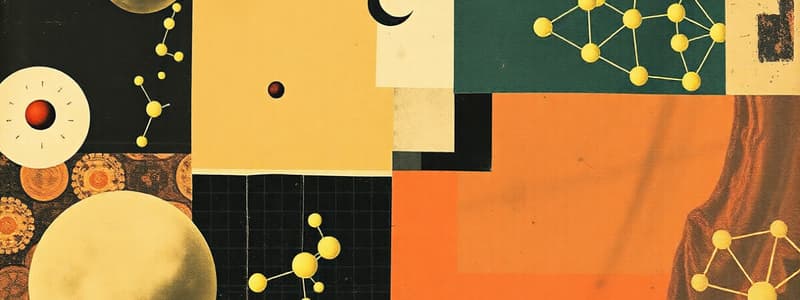Podcast
Questions and Answers
Triglycerides are the main form of energy storage in ______ and plants.
Triglycerides are the main form of energy storage in ______ and plants.
animals
Phospholipids are major components of cell membranes, forming the lipid ______.
Phospholipids are major components of cell membranes, forming the lipid ______.
bilayer
Steroids are characterized by a structure of four fused ______ rings.
Steroids are characterized by a structure of four fused ______ rings.
carbon
Waxes provide protective barriers in plants and ______.
Waxes provide protective barriers in plants and ______.
Sphingolipids are involved in signaling and cell recognition, especially in ______ cells.
Sphingolipids are involved in signaling and cell recognition, especially in ______ cells.
Lipids, particularly in the form of ______, provide thermal insulation and cushioning for organs.
Lipids, particularly in the form of ______, provide thermal insulation and cushioning for organs.
Dietary lipids include triglycerides, phospholipids, and ______, which are essential for energy and hormone synthesis.
Dietary lipids include triglycerides, phospholipids, and ______, which are essential for energy and hormone synthesis.
In the mouth, lingual lipase begins the digestion of triglycerides into ______ and free fatty acids.
In the mouth, lingual lipase begins the digestion of triglycerides into ______ and free fatty acids.
Micelles formed during digestion allow digested lipids to be absorbed by the intestinal ______.
Micelles formed during digestion allow digested lipids to be absorbed by the intestinal ______.
Chylomicrons are lipoprotein particles that transport dietary triglycerides from the intestine to ______.
Chylomicrons are lipoprotein particles that transport dietary triglycerides from the intestine to ______.
Flashcards are hidden until you start studying
Study Notes
Lipid Overview
- Lipids are hydrophobic or amphiphilic molecules, soluble in nonpolar solvents and generally insoluble in water.
- Essential functions include energy storage, cell membrane structure, and signaling.
Types of Lipids
-
Triglycerides (Triacylglycerols):
- Composed of glycerol and three fatty acids; primary energy storage in animals and plants; stored in adipose tissue.
-
Phospholipids:
- Structure includes glycerol, two fatty acids, and a phosphate group; critical components of cell membranes, contributing to membrane fluidity and barrier function.
-
Steroids:
- Composed of four fused carbon rings; includes cholesterol, vital for steroid hormone production (e.g., estrogen, testosterone) and membrane stabilization.
-
Glycolipids:
- Consist of glycerol, fatty acids, and carbohydrates; involved in cell recognition and communication within membranes.
-
Waxes:
- Made of long-chain fatty acids and alcohols; serve as protective barriers in plants and animals (e.g., plant cuticles, earwax).
-
Sphingolipids:
- Built on a sphingosine backbone with one fatty acid; significant in signaling and cell recognition, particularly in nerve and immune cells.
Functions of Lipids
- Energy Storage: Primarily served by triglycerides in adipose tissue.
- Structural Components: Phospholipids and cholesterol are fundamental to cell membrane architecture.
- Signaling Molecules: Lipids such as steroid hormones regulate physiological functions.
- Insulation and Protection: Lipids provide cushioning for organs and thermal insulation.
Dietary Lipids
- Include triglycerides, phospholipids, and cholesterol, crucial for energy, structure, and hormone synthesis.
Lipid Digestion and Absorption
-
Digestion:
- Begins in the mouth with lingual lipase; gastric lipase continues in the stomach; pancreatic lipase acts in the small intestine with bile salts to hydrolyze triglycerides into monoglycerides and free fatty acids.
-
Absorption:
- Digested lipids form micelles for absorption by intestinal mucosa; monoglycerides and fatty acids are reassembled into triglycerides and packaged into chylomicrons for transport.
Lipid Transport and Metabolism
-
Chylomicrons: Transport dietary lipids from intestines to tissues; hydrolyzed by lipoprotein lipase (LPL) for energy or storage.
-
VLDL: Transports endogenous triglycerides from the liver to tissues; also processed by LPL.
-
IDL: Intermediate form of VLDL; converts to LDL or taken up by the liver.
-
LDL: Carries cholesterol to tissues, often termed "bad cholesterol" due to atherosclerosis risk.
-
HDL: Collects excess cholesterol from tissues, transporting it back to the liver; known as "good cholesterol" for reducing cardiovascular risk.
Fatty Acid Metabolism
-
Synthesis:
- Occurs mainly in liver and adipose tissues; initiated by acetyl-CoA through the acetyl-CoA carboxylase (ACC) enzyme.
-
β-Oxidation:
- Takes place in mitochondria; fatty acids are activated to fatty acyl-CoA and broken down into acetyl-CoA, NADH, and FADH2.
Triacylglycerol Metabolism
- Synthesis: Involves glycerol-3-phosphate from glucose or glycerol; fatty acids are esterified to form triacylglycerols, catalyzed by diacylglycerol acyltransferase (DGAT).
Steroid Hormone Synthesis
- Location: Primarily in adrenal glands and gonads.
- Process: Cholesterol converts to pregnenolone and then to various steroid hormones, including glucocorticoids (e.g., cortisol) and sex steroids (e.g., estrogen).
Clinical Relevance
- Dyslipidemia: Elevated LDL, low HDL levels linked to increased cardiovascular disease risk.
- Obesity: Excess triglyceride accumulation in adipose tissue, a key factor in metabolic syndrome and type 2 diabetes.
- Fatty Liver Disease: Lipid accumulation in liver can lead to NAFLD or alcoholic liver disease.
Integration with Other Metabolic Pathways
- Lipid metabolism interacts with carbohydrate and protein metabolism, maintaining energy balance during fasting and feeding.
- Hormonal influences include insulin for lipogenesis and glucagon/epinephrine for lipolysis.
Cholesterol and Lipoprotein Disorders
-
Hypercholesterolemia: Elevated cholesterol levels increasing cardiovascular risk; managed through lifestyle and statin medications.
-
Familial Hypercholesterolemia: Genetic disorder causing high LDL, early atherosclerosis development.
Steroid Disorders
- Adrenal Insufficiency: Low adrenal steroid production, leading to fatigue and weight loss.
- Cushing’s Syndrome: Excess cortisol; symptoms include obesity, hypertension, diabetes.
Studying That Suits You
Use AI to generate personalized quizzes and flashcards to suit your learning preferences.




